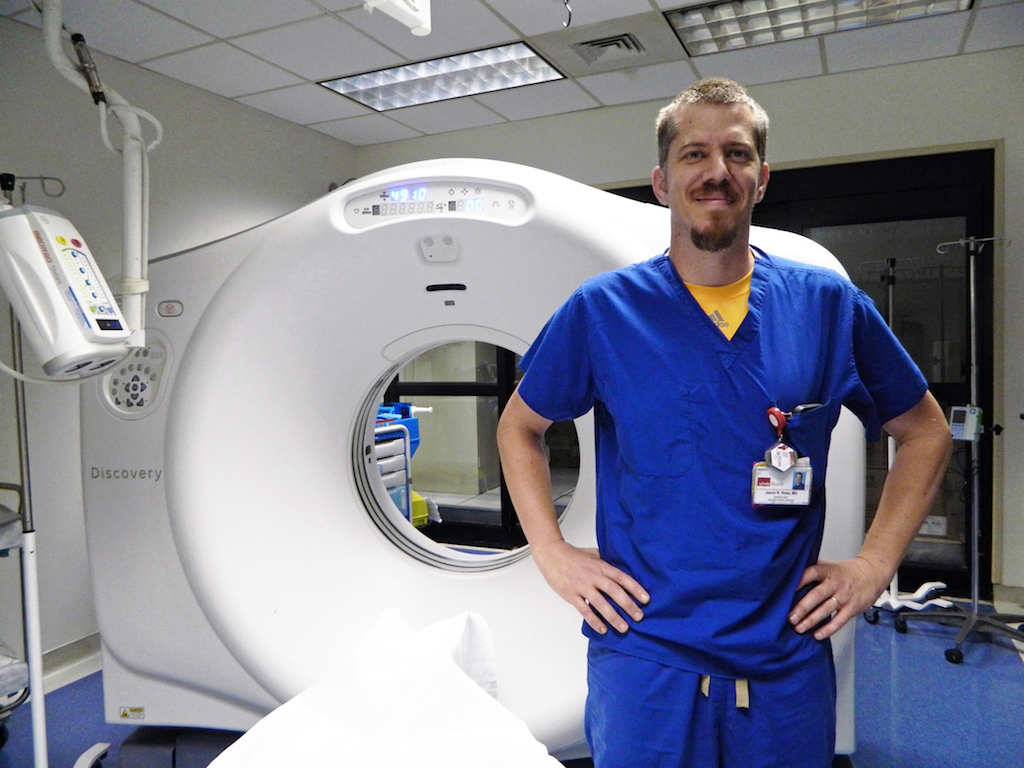
When Irene Slovak, who was an otherwise healthy 74-year-old woman, began experiencing stomach pain and fatigue, she knew something wasn’t right.
Although she didn’t have a primary care physician, she lived near the UTMB Multispecialty Care Clinic in League City, so she called and made the first available appointment with a nurse practitioner. Suspecting the patient was suffering from acid reflux or an ulcer, the NP ordered some tests and noticed Slovak’s liver enzymes were unusually high.
The NP immediately called the radiology department in Galveston to set up an appointment for Slovak to receive an ultrasound the following day. During the ultrasound, the technician noticed something she didn’t recognize. She called the manager in to review the ultrasound, who recognized the severity of the situation and called Dr. Jason Ross, a senior radiology resident, to review the case. Ross suspected cancer.
“I saw what was going on and it concerned me,” he said. “As a radiologist, I generally want bad news to come from someone who the patient knows—I don’t want to scare the patient. It’s better to have the primary care physician, the one who the patient has a relationship with, deliver news. They can do it better than I can.”
While reviewing the patient’s records, Ross noticed that Slovak did not have a primary care physician, and the NP from her original appointment was out of town, so he reached out to the clinic’s internal medicine physician for help. After assessing the situation over the phone, the physician asked Ross if he would be willing to talk to Slovak.
“It’s not something in my wheelhouse—not something I do every day—but she was a patient under my care. I was going to try to help, even if I was a little uncomfortable,” explained Ross. “For her peace of mind and continuity of care, I needed a CT scan to be performed that same day. As a radiologist, I don’t have a follow-up clinic, and the person who told her about the ultrasound needed to be the same person who told her about the CT results.”
Ross worked with the internal medicine physician to schedule the CT scan, talked to the patient’s insurance provider and then returned to explain to her what they suspected was the cause of her symptoms.
Slovak reflected on her experience that day. “I just had a feeling that there was something going on. I didn’t rule out cancer or think about cancer necessarily, but I was very grateful that I was going to get an answer that day.”
After the CT scan results were in, Ross met with Slovak and her husband and confirmed the mass was pancreatic cancer. By Monday, Slovak delivered the news to her children and was admitted to the hospital. She could finally receive something to ease the pain.
When asked if she would have preferred to hear her diagnosis from a primary care doctor, Slovak said, “Oh no. Dr. Ross saw the results first-hand. No other doctor knew as much about me as he knew, at the time. He did it very well. If it wasn’t for him, everything else would have been delayed and I would still be miserable.”
Ross shared the lessons he learned from this experience and what he hopes will help other specialists who may someday find themselves in a situation: “I sometimes feel like I didn’t do enough and I wish that I could do more. But what I hope other radiologists or specialists who don’t typically have direct relationships with patients will learn from this is, if a patient doesn’t have someone else, even if we’re uncomfortable, we can make a difference.”
For Irene Slovak and her husband, it was their radiologist and his dedication to compassionate and exceptional care who changed everything.
This story was originally featured in the Winter 2018 Academic Enterprise magazine. To see the entire issue, visit https://utmb.us/2fw.